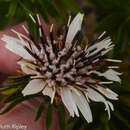Description
provided by Phytokeys (archived)
Shrubs 1–2 m tall, the branches erect to ascending; stems lacking spines. Leaves simple, sessile, in whorls at branch tips; blades lanceolate to oblanceolate, glabrous to glandular, usually appressed, the margins entire. Capitulescences of solitary, terminal heads, sessile. Capitula heterogamous, radiate or more rarely homogamous, discoid; involucres cylindrical to campanulate; receptacles plane, glabrous; phyllaries 5–7-seriate, lanceolate; ray florets 5–25, the corollas ligulate-bilabiate, the outer lip 4-nerved, tridentate, the inner lip bifid; styles cylindric, glabrous, bifid, the branches short, inconspicuous; disc florets 7–40, the corollas tubular, actinomorphic, glabrous, the limb deeply 5-lobed, the lobes greater than 1/3 the length of the corolla, coiled; anthers linear, the terminal appendages lanceolate, fused into a column, truncate, the bases caudate; styles claviform, the branches short, rounded. Achenes glabrous or glandular-pubescent; pappus of scabrid bristles, isomorphic, yellowish. Chromosome number: unknown.
- license
- cc-by-3.0
- copyright
- Michael O. Dillon, Federico Luebert
- bibliographic citation
- Dillon M, Luebert F (2014) Synopsis of Plazia Ruiz & Pav. (Onoserideae, Asteraceae), including a new species from northern Peru PhytoKeys 34: 1–13
- author
- Michael O. Dillon
- author
- Federico Luebert
Distribution
provided by Phytokeys (archived)
All species are confined to the Andean Cordillera and associated inter-Andean valleys (Fig. 1). Two species are confinded to Peru; both are rare and only known from a few collection localities. Another species is restricted to the Andes of central Chile. Plazia daphanoides Wedd. is the only wideranging species, being recorded from southern Peru and adjacent Argentina, Bolivia and Chile, usually in high-elevation, dry sites (Cabrera 1978, Ferreyra 1980, 1995).
- license
- cc-by-3.0
- copyright
- Michael O. Dillon, Federico Luebert
- bibliographic citation
- Dillon M, Luebert F (2014) Synopsis of Plazia Ruiz & Pav. (Onoserideae, Asteraceae), including a new species from northern Peru PhytoKeys 34: 1–13
- author
- Michael O. Dillon
- author
- Federico Luebert
Plazia: Brief Summary
provided by wikipedia EN
- license
- cc-by-sa-3.0
- copyright
- Wikipedia authors and editors

